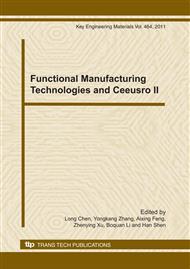p.327
p.332
p.336
p.340
p.344
p.350
p.354
p.358
p.362
Application of Genetic Algorithm in the Structural Optimization of Parallel Sensor
Abstract:
The parallel structure of the sensor, which based on Stewart platform, has a direct impact on the technical quota. This article uses Genetic Algorithm to parameterize the model of the sensor. Take the isotropy target of the sensor as objective function, and take five basic structural parameters of the Stewart platform as design variables. Then it optimizes the structure of the sensor. Then apply the virtual prototype technology of ADAMS to simulate. At last, it found the transformation relation between the isotropy target of the sensor and each parameter. It can offer an important gist for optimizing the structure of the sensor.
Info:
Periodical:
Pages:
344-349
Citation:
Online since:
January 2011
Authors:
Price:
Сopyright:
© 2011 Trans Tech Publications Ltd. All Rights Reserved
Share:
Citation:


